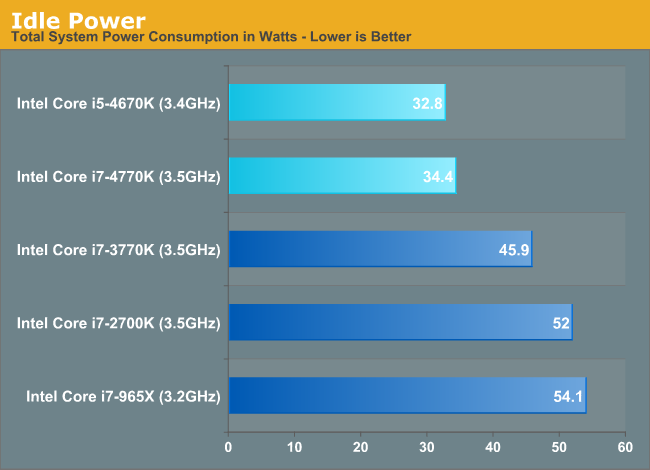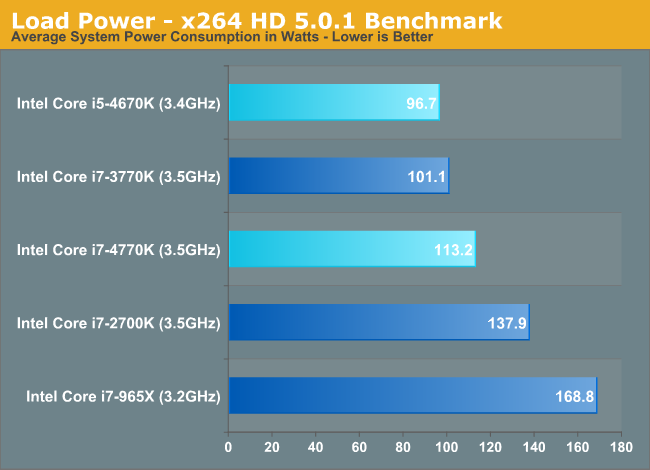The Haswell Review: Intel Core i7-4770K & i5-4670K Tested
by Anand Lal Shimpi on June 1, 2013 10:00 AM ESTPower Improvements
Although Haswell’s platform power is expected to drop considerably in mobile, particularly with Haswell U and Y SKUs (Ultrabooks and ultrathins/tablets), there are benefits to desktop Haswell parts as well.
There’s more fine grained power gating, lower chipset power and the CPU cores can transition between power states about 25% quicker than in Ivy Bridge - allowing the power control unit to be more aggressive in selecting lower power modes. We’ve also seen considerable improvements on lowering platform power consumption at the motherboard level as well. Using ASUS’ Z77 Deluxe and Z87 Deluxe motherboards for the Haswell, Ivy and Sandy Bridge CPUs, I measured significant improvements in idle power consumption:

These savings are beyond what I’d expect from Haswell alone. Intel isn’t the only one looking to make things as best as can be in the absence of any low hanging fruit. The motherboard makers are aggressively polishing their designs in order to grow their marketshare in a very difficult environment.
Under load, there’s no escaping the fact that Haswell can burn more power in pursuit of higher performance:

Here I’m showing an 11.8% increase in power consumption, and in this particular test the Core i7-4770K is 13% faster than the i7-3770K. Power consumption goes up, but so does performance per watt.
The other big part of the Haswell power story is what Intel is calling FIVR: Haswell’s Fully Integrated Voltage Regulator. Through a combination of on-die and on-package circuitry (mostly inductors on-package), Haswell assumes responsibility of distributing voltages to individual blocks and controllers (e.g. PCIe controller, memory controller, processor graphics, etc...). With FIVR, it’s easy to implement tons of voltage rails - which is why Intel doubled the number of internal voltage rails. With more independent voltage rails, there’s more fine grained control over the power delivered to various blocks of Haswell.
Thanks to a relatively high input voltage (on the order of 1.8V), it’s possible to generate quite a bit of current on-package and efficiently distribute power to all areas of the chip. Voltage ramps are 5 - 10x quicker with FIVR than with a traditional on-board voltage regulator implementation.
In order to ensure broad compatibility with memory types, there’s a second input voltage for DRAM as well.
FIVR also comes with a reduction in board area and component cost. I don’t suppose this is going to be a huge deal for desktops (admittedly the space and cost savings are basically non-existent), but it’ll mean a lot for mobile.
No S0ix for Desktop
You’ll notice that I didn’t mention any of the aggressive platform power optimizations in my sections on Haswell power management, that’s because they pretty much don’t apply here. The new active idle (S0ix) states are not supported by any of the desktop SKUs. It’s only the forthcoming Y and U series parts that support S0ix.










210 Comments
View All Comments
random2 - Monday, June 3, 2013 - link
Other reviewers are getting the more standard 10-15% difference on average across the board typically seen with Intel and a new gen. introduction over their previous gen. If it's not being seen here, maybe there are benches not included that should be.Achaios - Tuesday, June 4, 2013 - link
1.72 FPS difference between an i7-2600k and an i7-4770k. This is so hopelessly pathetic.My QX9650 and my Asus P5Q Deluxe just got a 2 year life extension. I wonder when it's going to be worth it to finally ditch my 2008 system!!!
Arbie - Wednesday, June 12, 2013 - link
The CPU does not control the FPS you're talking about. Beyond a certain point of CPU power (long ago passed) FPS depends on the external graphics card. A Haswell i7-4770K CPU will, according to the Anandtech benchmarks, be about twice as powerful as your QX9650. At 1/3 the cost, and far less idle power. That's not "pathetic".You may very well not want to upgrade, because you won't see a difference in your games - but that isn't Intel's fault. In fact it's a problem for them and the desktop market in general. Gains in CPU power are becoming irrelevant. As are PC games, BTW, which is why graphics cards are improving so slowly now. In two more years... it will be the same story, except more so.
monohouse - Sunday, June 23, 2013 - link
+1, I upgraded my system:from a E6750 (3800 Mhz, 4MB) to E8400 (4300 Mhz, 6MB)
from GTX 480 (840 Mhz, 1.5 GB) to GTX 580 (930 Mhz, 3 GB)
and got the same FPS in crysis 2 (with MaLDo HD + hi-res textures + DX11)
shows that in some cases, there is no improvement
Gastoncapo - Wednesday, June 5, 2013 - link
honestly, i'm still running my 2500k @5ghz ...i don't see the point in upgrading yet, guess i'll just switch my 580 gtx for a 780 :DNillerboy - Sunday, June 9, 2013 - link
will there be made a review of Intel 4770S?I am considering making a lab with this cpu, and would like to see proformence difference between the Intel 4770 and 4770S.
C433 - Wednesday, June 12, 2013 - link
second this, best would be to also include 4670S and at least one of the T modelsThomasS31 - Monday, June 10, 2013 - link
Anand,What is intels response to the overheating/throttling issues with stock cooler haswell (not OC).
Can you investigate this issue more (as you can as ususal).
Seems there are some manufacturing quality issues with the heat spreader and thermal paste.
Arbie - Wednesday, June 12, 2013 - link
Just some info for others considering a Haswell desktop build.I have just assembled an i5-4670K on an Asus Gryphon Z87 mATX mobo, with 8GB of Corsair Vengenace RAM (1333MHz) and a GTX 650ti graphics board. This is with a 250GB Samsung SSD and a old 500GB mechanical drive. The PSU is a Corsair CX600 80-Plus.
==> At stock clocks, idling on the Windows desktop, this PC pulls only 39W from the wall!
I am amazed. Idle power is important to me since the box is in a poorly-ventilated room. Upping the AC to improve that area would freeze the rest of the house AND cost a bundle. The time periods spent at full load are negligible in comparison. But the performance is there when needed... this CPU is nearly twice as powerful as my Yorkfield build, which idles at 170W, with HD 5770 gfx and an SSD.
So I'm very pleased with Haswell on the desktop. And yes, I could have bought a lower level chip and mobo for this use, saving money and a few more Watts, but I wanted the good stuff and the PC may someday be moved to where an OC would be practical.
emperius - Friday, June 14, 2013 - link
Well I certainly can wait for AMD to truly boost their competition from Sony and Microsoft's budget here. Let's face it, multi-year contract for console apu's should economically boost them massively.